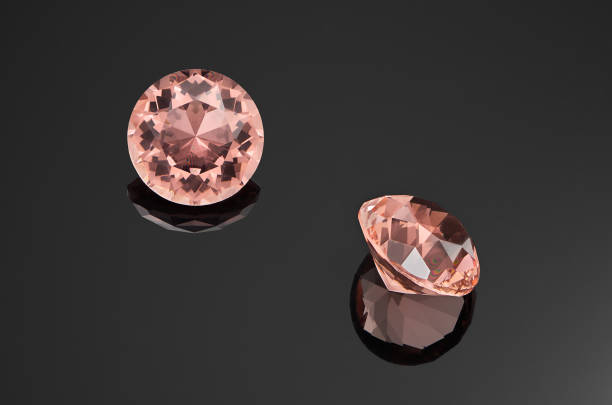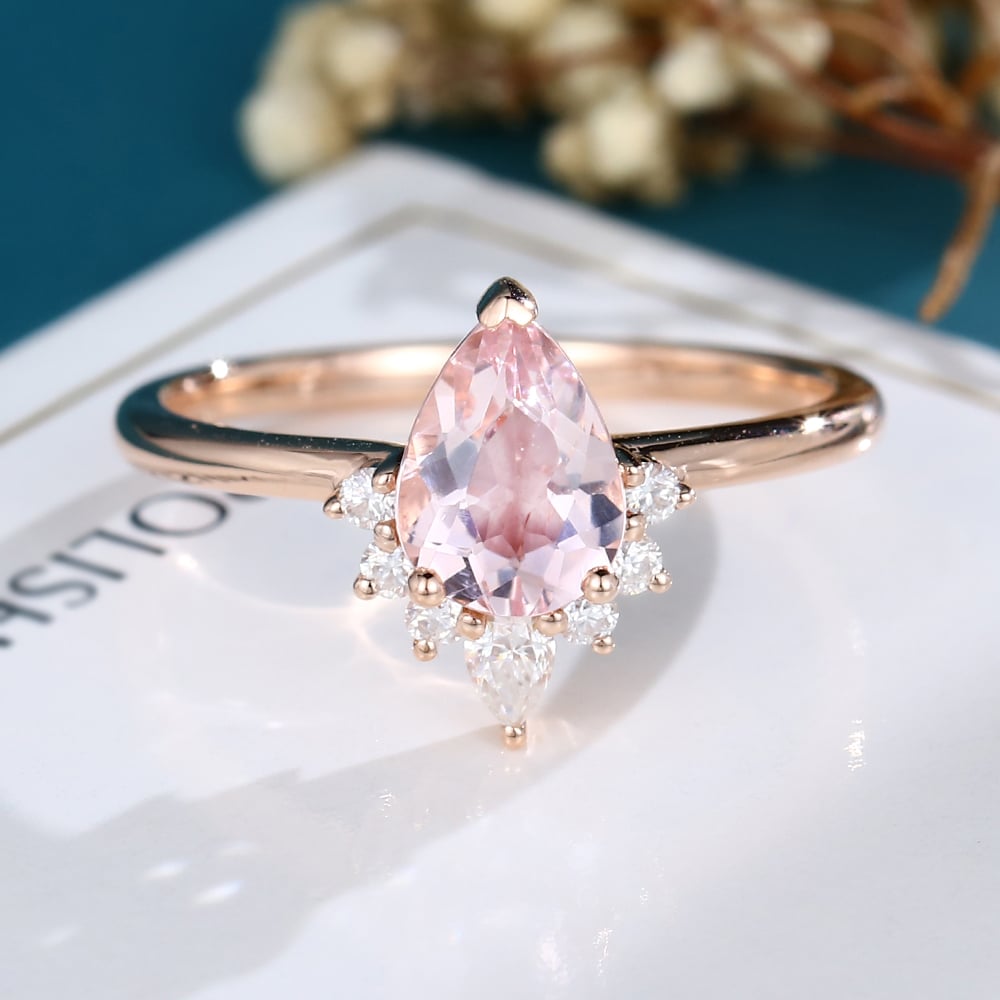Do you know morganite?
0 comments
SHOP BY STYLE ✧
SHOP BY SHAPE ✧
![]()
![]()
![]()
![]()
![]()
METAL COLOR ✧
WEDDING BANDS
SHOP BY STYLE ✧
![]()
![]()
![]()
SHOP BY STONE ✧
SHOP BY METAL ✧
JEWELRY FOR THE BIG DAY
NECKLACES ✧
EARRINGS ✧
BRACELETS ✧
Engagement ✧
SHOP BY SHAPE ✧
![]()
![]()
![]()
![]()
![]()
![]()
SHOP BY COLOR ✧
SHOP BY CATEGORY✧

SHOP BY CATEGORY✧
SHOP BY OCCASION✧
SHOP BY PRICE✧

Birthstone Jewelry

In the vast and vibrant world of gemstones, few have captivated the imagination and adoration of jewelers and enthusiasts quite like morganite. Known for its range of pink hues, from soft salmon to a deeper blush, morganite combines rarity, beauty, and durability, making it an increasingly popular choice for jewelry. This article will deeply explore the history, characteristics and charm of morganite, and reveal the cultural influence and geographical origin of morganite. Come and explore with LisaJewelryUS.
The discovery and subsequent popularity of morganite is a tale of gemological intrigue, international adventure, and the allure of beauty. This pink to peach gemstone, a variety of beryl, shares its family tree with illustrious relatives like emerald and aquamarine but has carved out its own niche in the world of fine jewelry thanks to its unique characteristics and the story of its discovery.
Morganite was identified as a distinct variety of beryl in 1910, thanks to the efforts of George D. Kunz, a self-taught gemologist who was the chief gem buyer for Tiffany & Co. The discovery was made when a remarkable sample of pink beryl was unearthed in Madagascar. This sample was unlike any beryl known at the time, distinguished by its striking pink hue, which ranged from a soft pastel to a vibrant salmon, depending on the light.
Kunz immediately recognized the importance of this find and advocated for the recognition of pink beryl as a gemstone in its own right. He named the stone “morganite,” in honor of J.P. Morgan, a titan of industry and one of the most prominent gem collectors of his era. Morgan was not only a patron of the arts and sciences but had also financed several of Kunz’s gem-collecting expeditions. The naming was as much an acknowledgment of Morgan’s contributions to the gemological field as it was a testament to his status in the early 20th century.
The naming of morganite after J.P. Morgan was symbolic, representing a convergence of science, art, and commerce. It underscored the role of patrons in advancing the field of gemology and highlighted the burgeoning relationship between gemology and the jewelry market. By associating the gem with Morgan, Kunz ensured its immediate entry into the annals of esteemed gemstones, elevating its status and desirability among collectors and the public.
Following its initial discovery in Madagascar, other significant deposits of morganite were found in Brazil, which became one of the leading sources of high-quality morganite. Over time, additional deposits were identified in countries across the globe, including Afghanistan, China, Mozambique, Namibia, Russia, and the United States, particularly in California and Maine. These discoveries expanded the availability of morganite, making it more accessible to jewelers and consumers worldwide.
In the years since its discovery, morganite has grown from a curiosity to a coveted gemstone in its own right. It is prized not only for its beauty and the range of pink shades but also for its clarity and durability. Morganite’s rise in popularity has been bolstered by a growing interest in colored gemstones for engagement rings and other fine jewelry, offering a unique and personal alternative to traditional diamonds.

The story of morganite’s discovery and naming encapsulates a fascinating moment in gemological history, reflecting the intersection of exploration, science, and high society. It highlights how the allure of the new and undiscovered drives the gemstone market, constantly evolving to capture the imagination of each new generation.
By delving into the rich history of morganite, we uncover not just the story of a gemstone but a narrative that encompasses global exploration, scientific achievement, and the timeless human attraction to beauty.
The geographical sources of morganite are as fascinating and diverse as the gemstone itself. While Madagascar was the original source of morganite, significant deposits have since been found in Brazil, Afghanistan, Mozambique, Namibia, and the United States, among other locations. Each region contributes subtle variations in color and quality, enriching the diversity of morganite available on the market.
Madagascar, where morganite was first discovered in 1910, is renowned for producing large, high-quality specimens with a pure pink hue. The island’s unique geological formations allow for the extraction of morganite crystals that are notable for their size and vibrant color. Even though Madagascar was the birthplace of morganite recognition, its mines are no longer the primary source of the market’s supply. However, the Madagascan morganite set a high standard for quality and color that other sources are still compared against.
Brazil quickly became a leading source for morganite following its discovery in Madagascar. The Minas Gerais region, in particular, is famous for its prolific production of gemstones, including top-quality morganite. Brazilian morganite is prized for its range of colors, from light pink to a deeper salmon, and is often available in large, clean crystals that are ideal for cutting into fine gemstones. The abundance and quality of Brazilian morganite have made it a staple in the jewelry industry.

Afghanistan is another significant source of morganite, with mines located in the rugged, mountainous areas of the country. The morganite from this region is known for its high clarity and rich, pink hues. The challenging terrain and remote locations of the mines add a layer of difficulty to the extraction and transportation of these gemstones, making Afghan morganite a prized find for collectors.
The source of morganite can influence not only the gemstone’s color and quality but also its value. Collectors and enthusiasts often seek out morganite from specific locations due to the unique characteristics imparted by its geographical origin. Moreover, the story of the stone’s journey from mine to market adds a layer of intrigue and provenance that can enhance its appeal.
As with many gemstones, the demand for ethical and sustainable sourcing practices has grown in importance among consumers. This is particularly relevant for morganite, given the diverse and sometimes challenging environments in which it is mined. Ethical sourcing ensures that the mining and distribution of morganite contribute positively to the communities involved and minimizes environmental impact, making the beauty of the gemstone all the more appreciable.
The geographical sources of morganite are a testament to the gemstone’s global appeal and the rich variety of colors and qualities available. Whether from the historic mines of Madagascar, the prolific regions of Brazil, or the rugged landscapes of Afghanistan, each source contributes to the tapestry of stories and characteristics that define morganite.
Morganite’s journey from obscurity to opulence is a testament to its allure and desirability. As more people discover this gemstone’s charm, it is poised to take its place among the pantheon of beloved jewels.